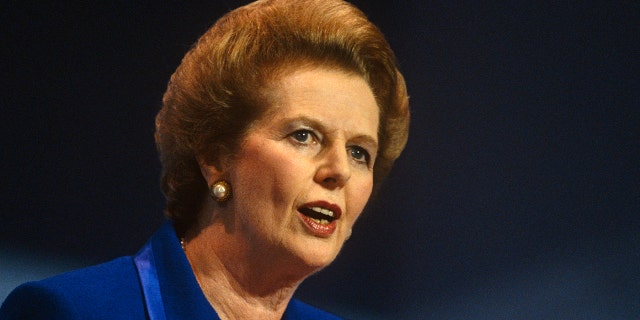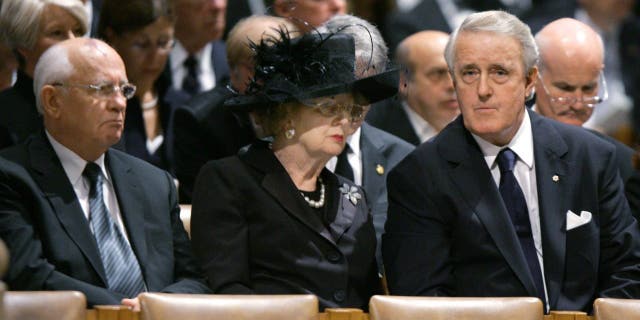On this day in history, May 4, 1979, 'Iron Lady' Margaret Thatcher becomes first female PM of the UK
Born in 1925, Thatcher became prime minister at age 54, led Britain for nearly 12 years
On this day in history, May 4, 1979, Margaret Thatcher — who led the United Kingdom's Conservative Party and ultimately came to be called the "Iron Lady" for her politics and leadership style — became the first female prime minister of the U.K.
An Oxford-educated lawyer and chemist, Thatcher took office the day after the Conservatives won the 44-seat majority in general parliamentary elections, according to History.com.
"During the election campaign," noted the BBC, "Thatcher said the Conservatives would cut income tax, reduce public expenditure, make it easier for people to buy their own homes and curb the power of the unions."
ON THIS DAY IN HISTORY, MAY 3, 1937, MARGARET MITCHELL'S CIVIL WAR SAGA ‘GONE WITH THE WIND’ WINS PULITZER
Here's more about her life and career.
An esteemed career
She was born Margaret Hilda Roberts in Grantham, England, in 1925, History.com notes.
Her esteemed career included being the first female president of the Oxford University Conservative Association; in 1950, she ran for Parliament in Dartford.

In this 1980 file photo, British Prime Minister Margaret Thatcher poses for a photograph in London. (AP)
In 1959, after marrying Denis Thatcher, a businessman, and later becoming a mother of twins, Thatcher was elected to Parliament as a Conservative for Finchley, a north London district, History.com notes.
During the decade of 1960, she quickly rose within the Conservative Party — and in 1967 joined the shadow cabinet sitting in opposition to Harold Wilson’s ruling Labor cabinet, the same source says.
She served as Britain's prime minister for almost 12 years.
With the victory of the Conservative Party under Edward Heath in 1970, Thatcher became secretary of state for education and science.

She served as Britain's prime minister for almost 12 years, between 1979 and 1990, the Margaret Thatcher Foundation reports.

This is a June 6, 1982, file photo of President Ronald Reagan and Britain's Prime Minister Margaret Thatcher at lunch at the Palace of Versailles, France. (AP1982)
"She was the first woman ever to hold that job, or to lead any big country in Europe or America, and became famous the world over," the foundation says.
Often referred to as "the Iron Lady," Thatcher, the same foundation notes, was pleased when she was given that nickname — by a Russian journalist, as it turned out — because she believed in being a strong leader.
LOOKING BACK AT QUEEN ELIZABETH AND MARGARET THATCHER'S ‘EXTRAORDINARY PARTNERSHIP'
Thatcher moved economic policy significantly to the right, and helped to set in motion international trends during the 1980s, the University of Cambridge indicates.
"The large state sector was progressively slimmed by ‘privatization,' with the state airline, the steel, telecommunications, gas, electricity and water industries all sold by share offer," the site says.
Control of inflation influenced economic policy — and by the end of her tenure, few argued that by tolerating higher inflation one could reduce unemployment, the Cambridge archives report.

"Direct taxes were cut and the growth of public expenditure controlled, aiming to reduce the proportion of national income spent by the state," the same source says.
Throughout the years 1979-1990, there were marked improvements in some key economic measures, such as labor productivity, the archives also indicate.
ON THIS DAY IN HISTORY, NOV. 4, 1980, RONALD REAGAN ELECTED PRESIDENT, HERALDING ‘MORNING AGAIN IN AMERICA’
The business environment was changed sufficiently to make Britain a favored destination for foreign investment in Europe.
Not everything went Thatcher’s way, however.

Prime Minster Margaret Thatcher is seen giving her last speech as Prime Minister at the October 1990 Conservative Party Conference in Blackpool, Lancashire, before being removed by her own colleagues a few weeks afterward. Her fighting spirit and stern expression gave her the reputation of "Iron Lady," with a gaze that made her opponents uncomfortable. (In Pictures Ltd./Corbis via Getty Images)
"Unemployment rose sharply during her first government, reaching more than 3 million in 1981. It did not begin to fall until 1986, more than halfway through her term," says the archives from Cambridge.
Thatcher might not have won reelection in 1983 had it not been for the Falklands War (March-June 1982), says Cambridge; it was the Argentine invasion of the islands that dramatically shifted the U.K.’s national mood.

"As a war leader, Thatcher proved impressive to the electorate, and aided by the skill and courage of the armed services, she gained a political victory almost as complete as the military," says the same site.
CORONATION ADVICE FROM ONE IN THE KNOW: GRENADIER GUARD AT QUEEN ELIZABETH II'S EVENT SPILLS SECRETS
There were some unsettling times during her premiership.
A terrorist bombing at a Conservative Party conference in Brighton in 1984 — the work of the Irish Republican Army — nearly killed Thatcher and several senior members of her government, says Britannica.com.
Continuing through her years as prime minister, Thatcher's relationship with President Ronald Reagan, who was in office from 1980 to 1989, placed her at the center of the resolution of the Cold War.

Former Soviet leader Mikhail Gorbachev (left), former British Prime Minister Margaret Thatcher (center) and former Canadian Prime Minister Brian Mulroney attend the state funeral of former President Ronald Reagan at Washington's National Cathedral June 11, 2004. (REUTERS/Kevin Lamarque)
"She played an important part in creating a new era of détente with the Soviets in her dealings with Mikhail Gorbachev," the same site indicates.
As her premiership progressed, "personal and political differences within the leadership proved politically fatal to Thatcher," says the site.

"And in November 1990, a contest was triggered by Michael Heseltine, following the resignation of Sir Geoffrey Howe over European policy."
Thatcher remained in Parliament until 1992.
Although Thatcher won a majority of the vote, "under party rules the majority was not sufficient to avert a second ballot. Faced with the possibility of defeat and discovering that she lacked the full-hearted support of many cabinet colleagues, she resigned as party leader and as prime minister," according to the Cambridge archives.
CLICK HERE TO SIGN UP FOR OUR LIFESTYLE NEWSLETTER
Thatcher remained in Parliament until 1992. At that time she entered the largely ceremonial House of Lords in retirement, says History.com.
Thatcher also wrote successful memoirs — including "The Downing Street Years" — and campaigned energetically on behalf of the Margaret Thatcher Foundation, says The Guardian.
She passed away at the age of 87 on April 8, 2013, in London, after suffering a stroke.
No comments: